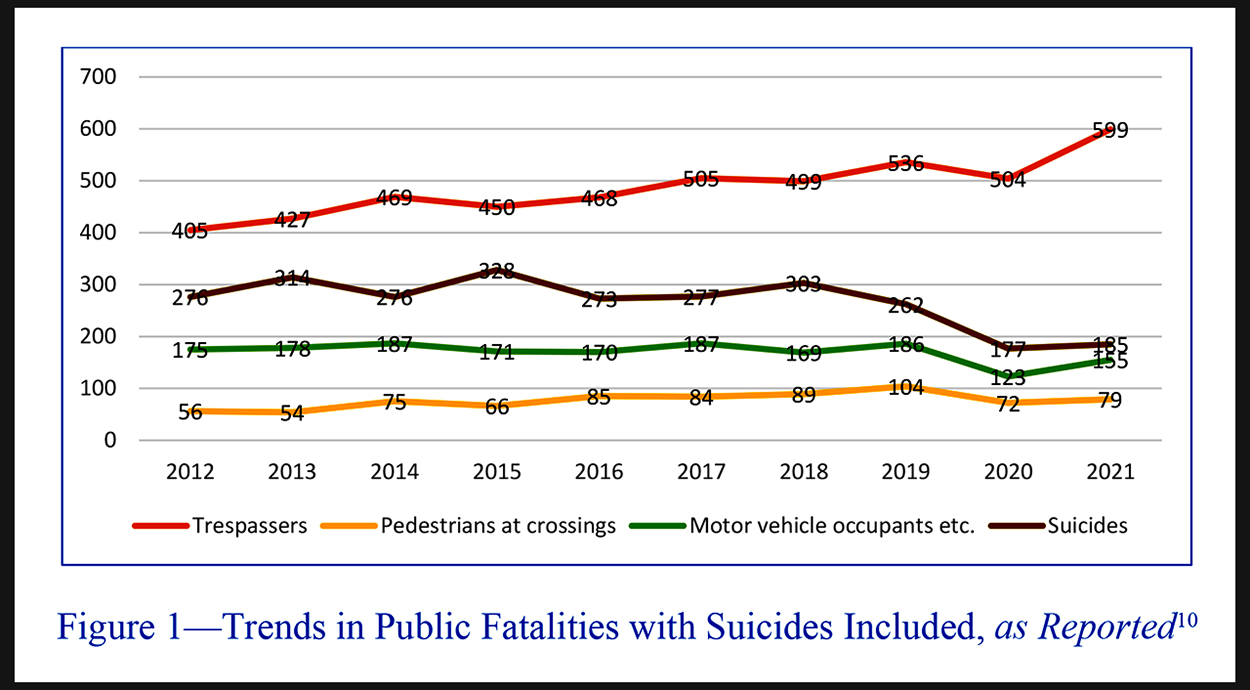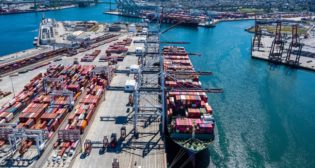
WHITE PAPER: Crossing Safety and Trespassing Prevention: Unfinished Business
Written by Grady C. Cothen Jr., Federal Railroad Administration (ret.)
Reporting of suicides went into effect for events beginning on June 1, 2011. Full-year numbers began in 2012. The numbers show that railroads initially made significant efforts to sort suicides from accidental deaths; however, at some point the efforts appear to have fallen off.
My principal responsibilities during my working life were focused directly on railroad safety, including work at the Federal Railroad Administration (FRA) from initial employment as a research assistant (legal clerk), attorney working in enforcement and regulations, a stint as Associate Administrator for Safety, and a long period in charge of safety standards and program development—36 years, altogether. After retiring in 2010, I worked for several years as a consultant (advisor) to a major transit authority and Amtrak.
When work life ended, I looked around for ways to remain useful. It seemed only fair that I retrace my steps to address, or at least define, those matters left unfinished when I took retirement.
The first White Paper in this series was devoted to “Management of In-Train Forces.” I shared multiple versions of the White Paper with colleagues at the FRA and National Transportation Safety Board, as well committees of the Congress. On June 14, 2022, I had the privilege to present testimony on the Subcommittee on Railroads, Pipelines and Hazardous Materials of the House Transportation and Infrastructure Committee that was based on the White Paper findings. Although management of in-train forces remains a significant rail safety issue for which work is unfinished (indeed, as of the date of this paper, still in the ditch), we have belabored that issue without notable effect. So, let’s move on to other, equally significant issues that merit attention, having some confidence that FRA will pick up the fallen standard and generate some progress.
As before, I make no pretense that I have answers to every safety need or that the items I call out in this paper or its sequels are the only matters that deserve attention. To the contrary, the reader can look at FRA’s regulatory agenda, NTSB’s list of recommendations, and other commentary for good ideas. To some extent, these efforts overlap the issues presented in this and subsequent papers. My purpose is to identify deficits in existing safety programs, add impetus to important work that is underway or contemplated, and, frankly, note some instances in which the Congress or the regulatory agencies have fallen short.
Perhaps not every issue identified here, or in the prior White Paper, requires a legislative or regulatory solution. That is for others to decide. However, in most cases, the issues selected have persisted for a very long time without evident progress to address them.
What About the Big Numbers?
As recently pointed out in an Eno Foundation report, trespassers on rail rights-of-way and users of highway-rail crossings (including, for this purpose, established pedestrian crossings) account for the vast majority of fatalities and serious injuries associated with railroad operations. The trespass problem is the larger segment. We didn’t need an Eno report to tell us this, of course, since it is common knowledge in the railroad community and in government.
Nevertheless, let it be said that we should be doing all we can to address casualties to pedestrians, bicyclists, persons with disabilities, motorists and their passengers, and others whether lawfully on public or private crossings or on the right-of-way without license to be there. The U.S. Department of Transportation, the state departments of transportation, the railroads and their employee organizations, Operation Lifesaver®, and many other dedicated groups have been working on these issues for decades, having expended billions of dollars and countless volunteer hours chipping away. FRA has focused in a commendable way on the problem of trespass risk, but the resulting strategy itself documents the difficulties involved.
With respect to the safety of motor vehicle occupants at crossings, at least, these efforts have led to remarkable progress. The issues still remain problematic because of their complexity and the fact of growing exposure (population growth and density, larger numbers of urban homeless persons, increasing vehicle miles, etc.).
The grade crossing issues have drawn the biggest investments. The investments have been successful to a considerable degree, more than cutting crossing fatalities in half since with mid- 1970s while exposure has increased substantially. However, the absolute numbers of incidents, injuries and deaths have remained pretty flat over recent years (Appendix A). Mandatory use of train horns, coupled with “quiet zone” options have helped to avoid disruption of community life while preserving safety at crossings. Improved regulations related to operation of commercial motor vehicles have raised awareness among professional drivers. Law enforcement to reinforce compliance with traffic control devices at crossings remains critical. Notably, the 2021 “Bipartisan Infrastructure Law” added billions of dollars of additional investments that may have significant benefits, particularly through grade separations, site-specific engineering improvements, and targeted public education and awareness campaigns.
The trespass numbers continue to grow, however; and the solutions are less obvious. Public education is a big component, but every message of a positive nature competes with many irresponsible posts on social media. Operation Lifesaver and other organizations continue to plug away at addressing the problem. Fencing and other improvements can help channel movements to properly configured pedestrian crossings where that makes sense, but those of us who have seen the effectiveness of wire cutters on fences in the northeastern U.S. know it is far from a complete solution. Thus, we agree that public policy should continue to complete the work on crossing safety and to address trespass risks.
DOWNLOAD THE WHITE PAPER:
Acknowledgements: A draft of this paper was reviewed by several expert colleagues who provided comments, needed corrections, and their own perspectives on the issues. I am indebted to these colleagues for taking valuable time to provide this input, without which this White Paper would be both flawed and incomplete. As always, my patient colleagues are not responsible for my stated viewpoints; and any errors that remain are my responsibility. Readers are invited to provide errata and substantive feedback through [email protected].

Retired rail transportation consultant Grady C. Cothen Jr. retired in 2010 from the Federal Railroad Administration after 36 years in various positions: Deputy Associate Administrator for Safety Standards and Program Development (1994-2010); Associate Administrator for Safety (1991-1994); and Special Assistant to the Chief Counsel for rail safety, labor protection and asset sale projects (1975-1991). Prior to that, he served as a trial attorney in the Enforcement Division of the FRA Office of Chief Counsel. Cothen was also Acting Associate Administrator for Policy from 1986-1988, where he provided executive direction for economic, financial and traffic analysis and freight policy studies, including recommendations for Departmental positions in rail proceedings before the Interstate Commerce Commission. Cothen holds a J.D. from Georgetown University Law Center and a B.A. in Government and History from Oklahoma Baptist University. The opinions expressed here and in the attached paper are his own.



